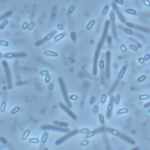Link to Pubmed [PMID] – 16701505
Anaerobe 2004 Apr;10(2):93-100
Botulinum and tetanus neurotoxins are structurally and functionally related 150 kDa proteins that are potent inhibitors of neuroexocytosis. Botulinum neurotoxin associates with non-toxic proteins to form complexes of various sizes. The botulinum neurotoxin and non-toxic protein genes are clustered in a DNA segment called the botulinum locus. This locus is probably located on a mobile or degenerate mobile element, which accounts for the various genomic localizations (chromosome, plasmid, phage) in different Clostridium botulinum types. The botulinum neurotoxin and non-toxic protein genes are organized in two polycistronic operons (ntnh-bont and ha operons) transcribed in opposite orientations. The gene that separates the two operons of the botulinum locus in C. botulinum A encodes a 21 kDa protein BotR/A, which is a positive regulator of the expression of the botulinum locus genes. Similarly, in Clostridium tetani, the gene located immediately upstream of the tetanus toxin gene, encodes a positive regulatory protein, TetR. BotR and TetR are possibly alternative sigma factors related to TxeR and UviA, which regulate C. difficile toxin and C. perfringens bacteriocin production, respectively. TxeR and UviA define a new sub-group of the sigma(70) family of RNA polymerase initiation factors. In addition, the C. botulinum genome contains predicted two-component system genes, some of which are possibly involved in regulation of toxinogenesis.
